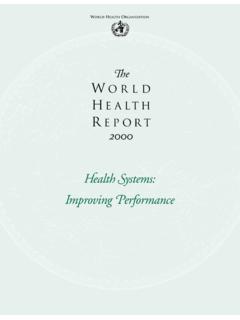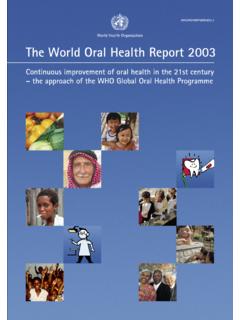Transcription of Is US Health Really the Best in the World?
1 COMMENTARY. Is US Health Really the Best in the world ? Barbara Starfield, MD, MPH measures used. Common explanations for this poor perfor- mance fail to implicate the Health system. The perception I. NFORMATION CONCERNING THE DEFICIENCIES OF US MEDI- is that the American public behaves badly by smoking, cal care has been accumulating. The fact that more than drinking, and perpetrating violence. The data show other- 40 million people have no Health insurance is well wise, at least relatively. The proportion of females who smoke known. The high cost of the Health care system is con- ranges from 14% in Japan to 41% in Denmark; in the United sidered to be a deficit, but seems to be tolerated under the States, it is 24% (fifth best).
2 For males, the range is from assumption that better Health results from more expensive 26% in Sweden to 61% in Japan; it is 28% in the United States care, despite evidence from a few studies indicating that as (third best). many as 20% to 30% of patients receive contraindicated The data for alcoholic beverage consumption are similar: In addition, with the release of the Institute of Medicine the United States ranks fifth best. Thus, although tobacco use (IOM) report To Err Is Human, 2 millions of Americans and alcohol use in excess are clearly harmful to Health , they learned, for the first time, that an estimated 44000 to 98000 do not account for the relatively poor position of the United among them die each year as a result of medical errors.
3 States on these Health indicators. The data on years of po- The fact is that the US population does not have any- tential life lost exclude external causes associated with deaths where near the best Health in the world . Of 13 countries in due to motor vehicle collisions and violence, and it is still the a recent comparison,3 the United States ranks an average of worst among the 13 Dietary differences have been 12th (second from the bottom) for 16 available Health in- demonstrated to be related to differences in mortality across dicators. Countries in order of their average ranking on the countries,5 but the United States has relatively low consump- Health indicators (with the first being the best) are Japan, tion of animal fats (fifth lowest in men aged 55-64 years in Sweden, Canada, France, Australia, Spain, Finland, the Neth- 20 industrialized countries) and the third lowest mean cho- erlands, the United Kingdom, Denmark, Belgium, the United lesterol concentrations among men aged 50 to 70 years among States, and Germany.
4 Rankings of the United States on the 13 industrialized separate indicators3 are: The real explanation for relatively poor Health in the United 13th (last) for low-birth-weight percentages States is undoubtedly complex and multifactorial. From a 13th for neonatal mortality and infant mortality overall Health system viewpoint, it is possible that the historic fail- 11th for postneonatal mortality ure to build a strong primary care infrastructure could play 13th for years of potential life lost (excluding external some role. A wealth of evidence3 documents the benefits of causes) characteristics associated with primary care performance.
5 11th for life expectancy at 1 year for females, 12th for males Of the 7 countries in the top of the average Health ranking, 10th for life expectancy at 15 years for females, 12th for 5 have strong primary care infrastructures. Although bet- males ter access to care, including universal Health insurance, is 10thforlifeexpectancyat40yearsforfemales ,9thformales widely considered to be the solution, there is evidence that 7th for life expectancy at 65 years for females, 7th for males the major benefit of access accrues only when it facilitates 3rd for life expectancy at 80 years for females, 3rd for males receipt of primary ,7 The Health care system also may 10th for age-adjusted mortality contribute to poor Health through its adverse effects.
6 For The poor performance of the United States was recently example, US estimates8-10 of the combined effect of errors confirmed by the world Health Organization, which used and adverse effects that occur because of iatrogenic dam- different indicators. Using data on disability-adjusted life age not associated with recognizable error include: expectancy, child survival to age 5 years, experiences with 12000 deaths/year from unnecessary surgery the Health care system, disparities across social groups in 7000 deaths/year from medication errors in hospitals experiences with the Health care system, and equality of fam- 20000 deaths/year from other errors in hospitals ily out-of-pocket expenditures for Health care (regardless Author Affiliation.)
7 Department of Health Policy and Management, Johns Hop- of need for services), this report ranked the United States kins School of Hygiene and Public Health , Baltimore, Md. as 15th among 25 industrialized Thus, the fig- Corresponding Author and Reprints: Barbara Starfield, MD, MPH, Department of Health Policy and Management, Johns Hopkins School of Hygiene and Public ures regarding the poor position of the United States in Health Health , 624 N Broadway, Room 452, Baltimore, MD 21205-1996 (e-mail: worldwide are robust and not dependent on the particular 2000 American Medical Association. All rights reserved. (Reprinted) JAMA, July 26, 2000 Vol 284, No.
8 4 483. COMMENTARY. 80 000 deaths/year from nosocomial infections in centages of low birth weight and infant mortality among the hospitals black population, because the international ranking hardly 106 000 deaths/year from nonerror, adverse effects changes when data for the white population only are used. of medications Whereas definitive explanations for the relatively poor po- These total to 225 000 deaths per year from iatrogenic sition of the United States continue to be elusive, there are causes. Three caveats should be noted. First, most of the data sufficient hints as to their nature to provide the basis for are derived from studies in hospitalized patients.
9 Second, consideration of neglected factors: these estimates are for deaths only and do not include ad- (1) The nature and operation of the Health care system. verse effects that are associated with disability or discom- In the United States, in contrast to many other countries, fort. Third, the estimates of death due to error are lower than the extent to which receipt of services from primary care those in the IOM If the higher estimates are used, physicians vs specialists affects overall Health and survival the deaths due to iatrogenic causes would range from 230000 has not been considered. While available data indicate that to 284000.
10 In any case, 225 000 deaths per year constitutes specialty care is associated with better quality of care for spe- the third leading cause of death in the United States, after cific conditions in the purview of the specialist,15 the data deaths from heart disease and cancer. Even if these figures on general medical care suggest National sur- are overestimated, there is a wide margin between these num- veys almost all fail to obtain data on the extent to which the bers of deaths and the next leading cause of death (cere- care received fulfills the criteria for primary care, so it is not brovascular disease). possible to examine the relationships between individual and One analysis overcomes some of these limitations by es- community Health characteristics and the type of care re- timating adverse effects in outpatient care and including ad- ceived.



